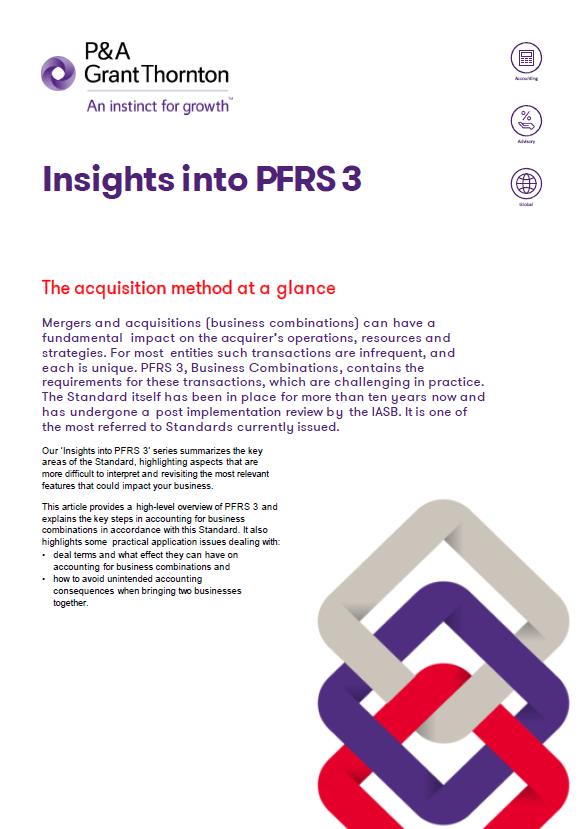This Accounting Alert is issued to give insights on the acquisition method under PFRS 3, Business Combinations.
Introduction
As one of the most referred to accounting standards, PFRS 3 has been in place for more than 15 years and has undergone a post-implementation review by the International Accounting Standards Board. In this accounting alert, we provide a high-level overview of PFRS 3 and explain key steps in accounting for business combinations.
Mergers and acquisitions (business combinations) can have a fundamental impact on the acquirer’s operations, resources and strategies. For most entities such transactions are infrequent, and each is unique. PFRS 3 contains the requirements for these transactions, which are challenging in practice. This insight summarizes the key areas of the standard, highlighting aspects that are more difficult to interpret and revisiting the most relevant features that could impact a business.
This article provides a high-level overview of PFRS 3 and explains the key steps in accounting for business combinations in accordance with this standard. It also highlights some practical application issues dealing with:
- deal terms and what effect they can have on accounting for business combinations and,
- how to avoid unintended accounting consequences when bringing two businesses together.
The Acquisition Method
PFRS 3 establishes the accounting and reporting requirements (known as ‘the acquisition method’) for the acquirer in a business combination. The key steps in applying the acquisition method are summarized below:
STEP 1: Identifying a business combination
Many transactions or other events involving the purchase of another entity or groups of assets require further analysis to determine whether: (a) what was acquired constitutes a business; (b) control, as defined by PFRS 10, has been obtained and (c) the combination is within the scope of PFRS 3.
STEP 2: Identifying the acquirer
PFRS 3 requires an in-substance approach to identify the party that obtained control (i.e. the acquirer). This approach looks beyond the legal form of the transaction and considers the rights of the combining entities and their former owners.
STEP 3: Determining the acquisition date
The acquisition date is the date the acquirer obtains control of the acquiree, usually the specified closing or completion date of the business combination.
STEP 4: Recognizing and measuring identifiable assets acquired and liabilities assumed
The most complex and time-consuming step which requires the acquirer to:
- recognize identifiable assets acquired and liabilities assumed at the acquisition date, including some intangible assets that may not have been previously recognized in the acquiree’s financial statements;
- measure identifiable assets acquired and liabilities assumed at fair value, with a few exceptions;
- determine the applicability of some specific recognition and measurement provisions; and,
- classify or designate the assets acquired and liabilities assumed.
STEP 5: Recognizing and measuring any non-controlling interest (NCI)
The acquirer has a choice to measure present ownership-type NCI at either fair value or the proportionate interest in the acquiree’s recognized identifiable net assets. The measurement of NCI affects the amount of goodwill that can be recognized and it can also impact post-combination reported results.
STEP 6: Determining the consideration transferred
Consideration transferred can include cash and other assets transferred, liabilities incurred, and equity interests issued by the acquirer. Some considerations may be deferred or be contingent on future events. In addition, consideration transferred in exchange for the acquired business may be different from the contractual purchase price if the overall transaction includes elements that are not part of the business combination exchange.
STEP 7: Recognizing and measuring goodwill or a gain from a bargain purchase
Goodwill or gain from a bargain purchase is measured as a residual amount.
Effect of Deal Terms on the Accounting for Business Combinations
The terms and structures of sales and purchase agreements vary extensively, and they will determine how a business combination should be accounted for. It is important that management is aware of the financial reporting consequences of putting in place certain terms and conditions into sale and purchase agreements. Each deal term or structure have effects on the financial reporting for business combination and it is important that management is aware of the financial reporting consequences of putting in place certain terms and conditions into sale and purchase agreements.
Reporting Business Combinations and Avoiding Surprises
A considerable amount of time and effort usually needs to be put into gathering, assembling and evaluating all the information required to be reported in the financial statements under PFRS 3. There are certain matters that need to be considered on the planning stage and knowing how to implement these will be a big help.
See attached Accounting Alert for further details.

